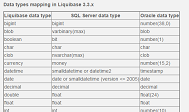 Designing a database, you have to choose data types for columns. It is not neutral which one is used. When you use Liquibase, you use an additional abstraction layer as it has its own data types. They are mapped to data types proper to a specific database engine later during scripts execution process. Choosing a data type, you should keep in mind the final data type on your database engine.
Designing a database, you have to choose data types for columns. It is not neutral which one is used. When you use Liquibase, you use an additional abstraction layer as it has its own data types. They are mapped to data types proper to a specific database engine later during scripts execution process. Choosing a data type, you should keep in mind the final data type on your database engine.
Data types mapping in Liquibase 3.6.x
| Liquibase data type | SQL Server data type | Oracle data type | MySQL | PostgreSQL |
| bigint | bigint | number(38,0) | bigint | bigint/bigserial |
| blob | varbinary(max) | blob | blob | oid |
| boolean | bit | number(1) | bit | bit |
| char | char | char | char | character |
| clob | nvarchar(max) | clob | longtext | text |
| currency | money | number(15,2) | decimal | decimal |
| datetime | datetime | timestamp | timestamp | timestamp |
| date | date | date | date | date |
| decimal | decimal | decimal | decimal | decimal |
| double | float | float(24) | double | double precision |
| float | float | float | float | float |
| int | int | integer | int | integer/serial |
| mediumint | int | mediumint | mediumint | mediumint |
| nchar | nchar | nchar | nchar | nchar |
| nvarchar | nvarchar | nvarchar2 | nvarchar | varchar |
| number | numeric | number | numeric | numeric |
| smallint | smallint | number(5) | smallint | smallint/smallserial |
| time | time | date | time | time |
| timestamp | datetime | timestamp | timestamp | timestamp |
| tinyint | tinyint | number(3) | tinyint | smallint |
| uuid | uniqueidentifier | raw(16) | char(36) | uuid |
| varchar | varchar | varchar2 | varchar | varchar/character (varying) |
For other Liquibase articles, please read:
Database versioning - theory [video]
Database versioning part 2 - Liquibase - how to use [video]
